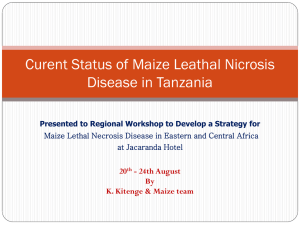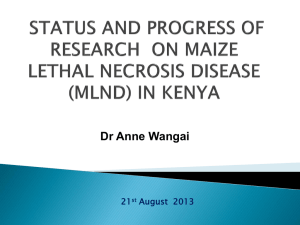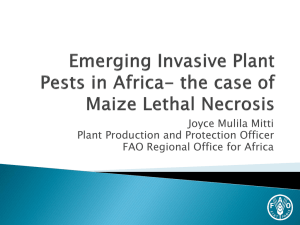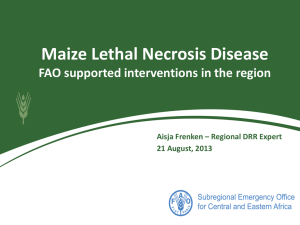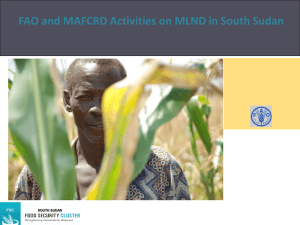Maize Lethal Necrosis Disease:Identification and
advertisement
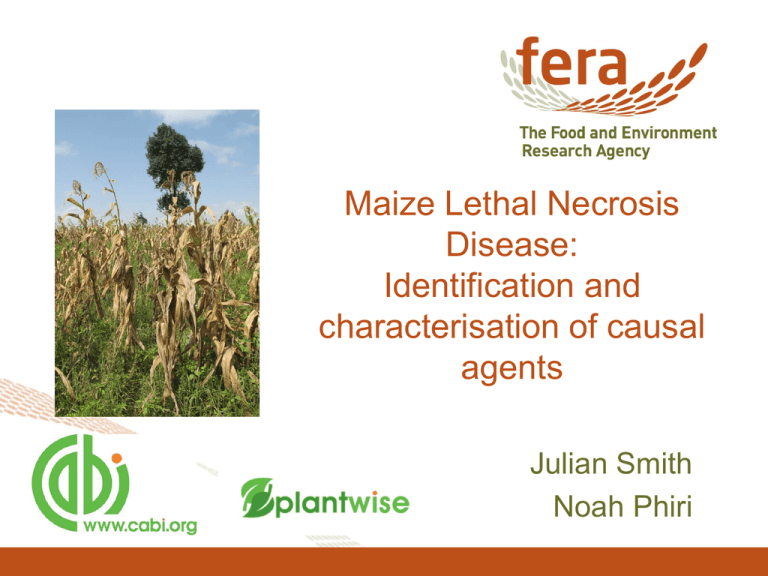
Maize Lethal Necrosis Disease: Identification and characterisation of causal agents Julian Smith Noah Phiri Symptoms Identification at Fera in the UK Received samples of first ‘outbreak sites’ in Kenya via CABI in early 2011 ‘Traditional’ identification methods proved inconclusive Realised the significance of the situation and need for an answer Next generations sequencing (NGS) for identification of unknowns Good at identifying what is known and familiar Challenged when faced with a new problem NGS was used to seek out all virus, bacterial, fungal nucleic acid sequences in infected samples Quantification and assignment of nucleic acid ‘signatures’ to organisms Probable causal agents Maize Chloritic Mottle Virus (MCMV) and Sugarcane Mosaic Virus (SCMV) were shown to account for the vast majority of viral nucleic acid MCMV and a potyvirus associated with Maize Lethal Necrotic Disease No other organisms seemed to fit a ‘probable cause’ hypothesis Confirmation of association of MCMV and SMV Real-time PCR assays developed and tested on individual samples MCMV identified with all samples SCMV identified with some samples only Plant test gave symptoms on maize and barley for MCMV only Inoculation of MCMV on Maize Inoculation of MCMV on Barley Nucleic acid alignment with Genbank accessions MCMV had absolute similarity to a accession described in China, and was with minor separation from US accessions SCMV had a strong similarity to accessions of Asian origin, that were characteristic of the region and quite distinct from other SCMV accessions sequence of other regions Identification of MCMV in Rwanda Samples received via CABI in 2013 7 samples looked at and MCMV has been found in all, but no SCMV or potyvirus has been found Characterisation shows these strains to be 100% identical to Kenyan strains Awaiting further test data for any potyvirus associated with samples Identification with farmers – the example of Plantwise Plantwise is a CABI product that gathers and assimilates data on plant pests for support to research, policy and the private sector Plantwise consists of two main elements − Knowledge bank − Plant Health Clinics Grass roots knowledge from Plant Clinics Plant Health Rally in DR Congo. A farmer discusses what she sees on cassava with a plant doctor. Follow-up identified first country report of CBSD Plant Clinics provide extension services, modelled on a doctors surgery The two-way flow of information is gathered and assimilated A variation on Plant Clinics has been successfully employed to focus on priority pests Termed Plant Health Rallies, these events provide tailored information on a specific pests such as MLND MLND Plant Health Rallies in Kenya for determining distribution and giving advice Map of Plant Health Rally locations held in Kenya, 2013 Events held in public gatherings A fact sheet on MLND symptoms was produced and shared with farmers Many events held in a short space of time reaching many 100s of farmers Information gathered on distribution of MLND Some key questions – amongst many Syngenta and Syngenta Foundation staff review efficacy of trials to control MLND, 2012 Is MCMV the primary causal agent; what role, if any, is with the potyvirus What are contributions of insect vectors, alternate hosts and seed in local and disparate spread? How do we map distribution and achieve early outbreak notice Can visual field inspection be sufficient for certification? What IPM packages for farmers and industry? What are the roles of government and industry in control? Thank you Staff of KEPHIS, KARI and Pannar Seed working at Fera on developing the diagnostics and methods for MLND detection
